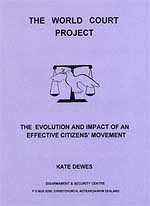The World Court Project: The Evolution And Impact Of An Effective Citizens' Movement
Doctoral Dissertation
by Kate Dewes April 1999
472 pages printed by the Disarmament & Security Centre Christchurch, New Zealand
CONTENTS
List of Illustrations
Preface
Acknowledgements
List of Abbreviations
List of Characters
Abstract
Chapter 1 INTRODUCTION
PART I. WORLD COURT PROJECT ORIGINS: 1945-1990
Chapter 2 INTERNATIONAL INFLUENCES FROM CITIZEN GROUPS AND INDIVIDUALS: 1945-1981
2.1 Introduction
2.2 International Committee of the Red Cross
2.3 Sean MacBride
2.4 Legal Views
2.5 The Military
2.6 International Peace Bureau
2.7 World Peace Council
2.8 Scientists and Physicians
2.9 Women's International League for Peace and Freedom
2.10 Conclusions
Chapter 3 THE 1980s: WOMEN MOBILISE
3.1 Introduction
3.2 Actions Inspired by Women
3.3 Oxford Research Group
3.4 Four Politicians:Theorin, Kelly, Vallentine, Lini
3.5 Women-Only Actions Greenham Women's Peace Camp
3.6 Conclusions
Chapter 4 THE 1980s: OTHER DOMESTIC INITIATIVES
4.1 Introduction
4.2 United Kingdom:
Campaign for Nuclear Disarmament
International Law Against War
London Nuclear Warfare Tribunal & MacBride Appeal
Pax Legalis
Institute for Law and Peace
Snowball
4.3 Other Countries:
Japan
West Germany
Netherlands
Canada
United States
4.4 Conclusions
Chapter 5 GOVERNMENTS RESPOND
5.1 Introduction
5.2 Treaties and Resolutions: 1945-1980
5.3 The 1980s: A Decade of New Thinking
5.4 Unilateral Actions by States
5.5 Nuclear Free Zones
5.6 Conclusions
PART II WORLD COURT PROJECT GESTATION :1986-1992
Chapter 6 CITIZENS MOBILISE IN AOTEAROA/NEW ZEALAND: 1986-1990
6.1 Introduction
6.2 Harold Evans
6.3 Open Letters
6.4 Richard Falk's Visit
6.5 Edward St John
6.6 Approaches to Governments
6.7 Approaches to Citizen Groups:
Lawyers
Physicians
6.8 Public Advisory Committee on Disarmament and Arms Control and the Third UN Special Session on Disarmament
6.9 Conclusions
Chapter 7 AOTEAROA/NEW ZEALAND GOVERNMENT POLICIES: 1945-1990
7.1 Introduction
7.2 Tacit Support for Nuclear Weapons 1945-1972
7.3 Using the International Court of Justice 1973-1974
7.4 Emerging Nuclear Allergy 1972-1984
7.5 "The Kiwi Cure " 1984-1990s
7.6 Labour Government's Response to the WCP 1986-1990
7.7 Conclusions
Chapter 8 INTERNATIONAL MOBILISATION: 1988-1992
8.1 Introduction
8.2 Citizen Groups:
World Association of World Federalists
British Connections
International Association of Lawyers Against Nuclear Arms (IALANA)
Links with the Commonwealth Parliamentarians
8.3 United Nations 1991
New York
Geneva
8.4 Other Groups
8.5 WCP Co-Sponsors
8.6 WCP International Launch
8.7 Conclusions
PART III. WORLD COURT PROJECT PROGRESS IN THE UN: 1992-1996
Chapter 9 APPROACHES TO THE WORLD HEALTH ORGANISATION
9.1 Introduction
9.2 Erich Geiringer
9.3 International Physicians for the Prevention of Nuclear War (IPPNW)
9.4 World Health Assembly 1992
Preparation
Ann Marie Janson and George Salmond
Presenting the Resolution
Lessons Learned
9.5 World Health Assembly 1993
Preparation
WHO Executive Board Meeting
Resolution and Voting
Role of Citizen Groups
9.6 From the World Health Assembly to the ICJ
9.7 Conclusions
Chapter 10 BUILDING PUBLIC AND GOVERNMENT SUPPORT: 1992-1994
10.1 Introduction
10.2 Public Participation
Declarations of Public Conscience
Endorsing Groups and Prominent Individuals
10.3 Case Study of Aotearoa/New Zealand: 1992-1994
10.4 WHA Submission to the Court and UNGA Resolution
10.5 Conclusions
Chapter 11 UN GENERAL ASSEMBLY RESOLUTIONS: 1993 AND 1994
11.1 Introduction
11.2 Alyn Ware
11.3 Lobbying New York Diplomats and Governments
11.4 Role of the Non-Aligned Movement
11.5 UN General Assembly: 1993
11.6 UN General Assembly: 1994
11.7 Conclusions
Chapter 12 GOING TO COURT: 1994-1996
12.1 Introduction
12.2 Submissions to the Court
World Health Assembly Question
UN General Assembly Question
12.3 Aotearoa/New Zealand Reopens 1973 Nuclear Tests Case
12.4 Commonwealth Heads of Government Meeting
12.5 Citizens Gather at The Hague
12.6 Oral Proceedings:
Australia
Non-Aligned Movement
Representatives South Pacific Islands
Japan and San Marino
Nuclear Weapon States and their Allies
12.7 Conclusions
PART IV. CONCLUSIONS
Chapter 13 THE IMPACT OF THE WORLD COURT PROJECT
13.1 Responses to the Court's Decision
13.2 Preparing the Ground
13.3 Reasons for Success
13.4 The Role of Small States
13.5 The Role of Women
13.6 Aotearoa/New Zealand Government Reluctance
13.7 Impact on Nuclear Disarmament
13.8 Impact on Peace Movements
13.9 Lessons Learned
13.10 Concluding Thoughts
Chronology
Appendix I. Precursors to WCP
II. Citizen Evidence
III. WHA and UNGA ICJ resolutions
Sources Consulted
